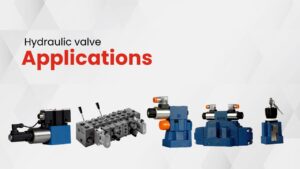From excavators, forklifts, tractors, to mining rigs, even industrial presses—hydraulic systems are what power some of the meanest machines around, in this world. Yet, while these machines appear ferocious and unstoppable, their efficiency only rests on the shoulders of a small but mighty element – hydraulic cylinder seals.
They are the silent, unseen workhorses of the system, preventing leaks, maintaining pressure, and sealing the cylinder from dirt and contaminants. These are what can bring even the strongest hydraulic system to a screeching halt. Unfortunately, seals don’t last forever. Eventually, they succumb to wear, crack, or fail, resulting in diminished performance or even catastrophic failure.
However, early detection of problem seals is the key to preventing thousands of dollars in maintenance and lost downtime. The following guide will explain why seals fail, how to see hydraulic cylinder seals for sale on the wall before it is too late, and outline prevention and replacement measures.
Importance of Hydraulic Cylinder Seals
Fluid pressure is converted into mechanical force by hydraulic cylinders. In terms of implementation, this process only works if the right amount of pressure and fluid containment is maintained within the system. To maintain this balance, hydraulic cylinder seals do the following:
Keep in location: Seals work to keep the hydraulic oil in its intended location, preventing it from leaking out of the cylinder.
Seals to Maintain Pressure: A cylinder will lose its force and performance if the seals are not airtight.
Keep Dirt Away: Seals prevent dust, dirt, and water from entering hydraulic systems, which can damage their operation.
Decreasing Wear and Tear: By reducing friction between the piston rod and housing, seals prolong the life of the machinery.
Long story short: No good hydraulic cylinder seals and even the most cutting-edge technology will perform sub-par or not at all.
Typical Examples of Why Seals Wear Down or Get Damaged
Seals do not fail instantly but rather over time under controlled conditions. Knowledge about these causes will enable the operators to take preventive action.
Excessive Heat
Like any other operating mechanism, a hydraulic servo system produces heat. Seals that are too hot may become hard, shrink, and/or crack, rendering them less effective.
Contaminated Fluids
Dirty oil is a silent killer. The hydraulic fluid can contain small particles that scratch and damage seals, resulting in leaks and performance issues.
Poor Installation Practices
What can happen is that using improvised tools for the seal’s installation can cause damage to its edges or improper seating of the seal, resulting in premature failure.
Wrong Seal Selection
Not all seals are made for all machines. The service environment of a seal must match its pressure, fluid, and temperature range to achieve a long lifetime. If not, its life is reduced.
Natural Aging
Tires wear out after thousands of miles, seals become decrepit after millions of working hours. You cannot prevent aging, but the timely replacement of hydraulic cylinder seals can avoid big problems.
Common Red Flags that Indicate Seal Trouble
Catching seals that are damaged earlier can allow you to book maintenance before a small issue becomes a major expense. These are some of the main symptoms to watch out for:
Fluid Leaks
Found oil around the piston rod, on cylinder ends, or on the ground are major warning signs. Seals are made not to leak. It does not take much — even small drips can indicate a problem.
Loss of Hydraulic Power
If the seals start to relieve pressure, the cylinder cannot create maximum force. Some machines may feel weak, while others may struggle to lift loads they used to clear with ease.
Cylinder Drift
Hydraulic cylinder are designed to hold their position under load if the seals are holding properly. Seals are likely worn out if the arm or attachment attached to your machine slowly sinks to the bottom.
Odd Noises During Operation
Fluid is bypassing seals, and this is often an indication of hissing or squealing sounds. Grinding noises could be a telltale sign that contaminants have worn away the seals and the metal parts.
Visible Seal Wear
During the routine checks, look for signs of deterioration (cracks, chips, flattening, or material build-up). Even a visible sign of damage requires a replacement.
Guide to Replacing Seals for Hydraulic Cylinders
You need more than just new parts and goodwill when replacing seals; you need precision. To help you out, here is a simple hydraulic cylinder seal replacement guide:
Depressurize and Drain
Safety first. Bleed out the hydraulic pressure and the fluid to prevent any accidents.
Disassemble the Cylinder
Be careful, pull the cylinder out, and disassemble it. You need to document each step you take so that when you assemble it, it goes back together nicely.
Inspect Metal Parts
Inspect the rod, piston, and barrel for scratches or scoring. New seals can be quickly damaged by ripped metal.
Remove Old Seals
Seal picks or specialized seal removal tools. If you have tough seals to remove, these are excellent tools for the job. Don’t scratch grooves or sealing surfaces.
Install New Seals
Use hydraulic cylinder seals of the same size and specification, with very close tolerances, and lubricate them lightly before installation. Orientation is critical; follow the manufacturer’s guidelines.
Reassemble and Test
Reassemble it, reinstall the cylinder, and run it under load in a safe environment. After the machine is rinsed and dry, inspect it for leaks and creep before returning it to full rotation.
Preventive maintenance: Extend the life of your seals
As much as hydraulic cylinder seals for sale replacement is a degree of ownership, far-reaching preventative upkeep can exponentially increase their life:
Conduct Regular Inspections: During your daily checks, look for leaks, unusual sounds, or drops in performance.
Fluid Cleanliness: Filter, oil change frequency, reservoir seals
Exceed Temperature Ratings: Do Not Overheat Hydraulic Systems
Store Properly: Spare hydraulic cylinder seals for sale should be stored in sealed packaging, away from direct sunlight and sources of chemicals.
Opt for Quality: Quality seals have an inherent upfront price, but opting for these will keep you free of costly downtime and hassle in the future.
Bottom Line
Hydraulic seals are small in size but high in responsibility. Even one old or damaged seal can cause leaks, resulting in lost productivity, safety hazards, and expensive downtime. When you notice the early warning signs, such as leaks, drift, or lost power.
This hydraulic cylinder seal replacement guide, combined with proper maintenance practices and regular inspections, is designed to help you keep your machines in optimal working condition. When it’s time to replace, always use machine-specific seals designed to withstand your machine’s unique operating conditions.
THM Huade is the world’s leading manufacturer of high-quality, durable & reliable hydraulic components and sealing solutions, ensuring your machines remain in service longer, stronger, and safer—your peace of mind in hydraulic solutions.
FAQs About Hydraulic Cylinder Seals
Q2. Is it possible to repair hydraulic cylinder seals' leaks instead of changing them?
While there are instances of temporary patches for minor leaks, actual hydraulic cylinder seal leak repair often requires complete replacement. Patch jobs often have a very short shelf life, making proper replacement the best option most of the time.
Q3. Can I perform hydraulic cylinder seal leak repair instead of replacing them?
However, well-made aftermarket seals, such as those from a trusted supplier, are a different story. That said, low-cost seals may not be able to withstand the pressure or temperature in your machine. It is best to always use quality hydraulic cylinder seals for long-term durability.
Q4. Question: Where can I find the seals for my machine?
Refer to your machinery manual for its specifications and buy your hydraulic cylinder seals from trusted sellers. This ensures compatibility and performance.


